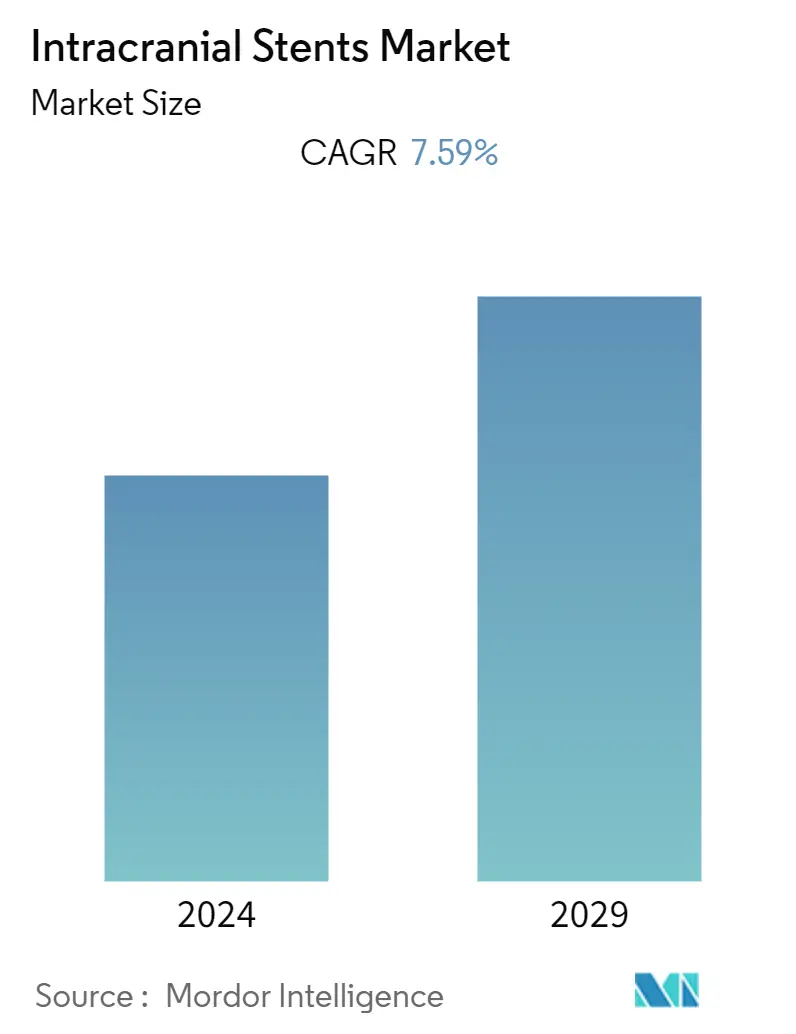Market Size of Intracranial Stents Industry

| Study Period | 2021 - 2029 |
| Base Year For Estimation | 2023 |
| CAGR | 7.59 % |
| Fastest Growing Market | Asia Pacific |
| Largest Market | North America |
| Market Concentration | Medium |
Major Players
*Disclaimer: Major Players sorted in no particular order |
Intracranial Stents Market Analysis
The intracranial stents market is expected to register a CAGR of 7.59% over the forecast period.
The COVID-19 pandemic has impacted the growth of the intracranial stents market. The delays in performing elective procedures due to COVID-19-related measures had adversely affected the intracranial stents market, especially in 2020, as most of the procedures were canceled or postponed due to the diversion of resources toward the COVID-19 patients. There was a significant decrease in surgical procedures worldwide. For instance, according to the report of the British Journal of Surgery, in May 2020, around 48,728 surgical procedures per week were canceled in India which is estimated around 585,000 surgical procedures for 12 weeks. However, with the released COVID-19 restrictions, resumed surgical procedures and increased hospital visits and admissions due to accidents, the studied market is expected to recover from the decline of COVID-19 in the next two-three years.
Factors such as the rising prevalence of stroke, increasing demand for minimally invasive intracranial surgeries, and the growing geriatric population are boosting the market growth. For instance, as per the World Stroke Organization report of 2022, more than 12.2 million new stroke cases are reported each year, globally. In addition, as per the same source, the prevalence of stroke is highest among people aged 70 years and above (67%), followed by people aged between 15-49 years (22%). Thus, the high burden of stroke coupled with the increasing geriatric population is expected to increase the demand for stent-retriever thrombectomy treatment for removing blood clots forming the brain. This is anticipated to fuel the market growth over the forecast period.
Additionally, as per an article published in the Egyptian Journal of Neurology, Psychiatry, and Neurosurgery, in October 2022, intracranial atherosclerotic stenosis (ICAS) is one of the main causes of stroke worldwide and its prevalence varies depending on the demographic, with Asians, Hispanics, and African Americans. In addition, as per the same source, ICAS affects 10% of the estimated 900,000 strokes or transient ischemic episodes (TIAs) yearly, and the probability of recurrence in these patients is 15% annually. Also, the Asian populations have a greater rate of strokes (33-50%) that can be attributed to ICAS as compared to the United States and western nations (10-15%). Thus, the high burden of ICAS among the population is expected to increase their risk of experiencing a stroke. This in turn is anticipated to fuel the demand for intracranial stenting procedures, hence propelling the market growth.
Furthermore, the rising company and university activities in developing technologically advanced stents are also contributing to the market growth. For instance, in January 2022, MicroPort NeuroTech Limited enrolled the first patient in the PROMISE Study, a pre-market clinical study for the Rebridge Intracranial Visualized Stent evaluating the treatment of an intracranial aneurysm. Therefore, owing to the aforementioned factors the studied market is expected to grow over the forecast period. However, the lack of skilled professionals for operating using intracranial stents and cerebrovascular complications related to intracranial stenting are likely to impede the growth of the intracranial stent market over the forecast period.
Intracranial Stents Industry Segmentation
As per the scope of the report, intracranial stents are small tubes that are placed into brain arteries that open the blocked arteries, allowing improved blood to flow to the brain or fill the aneurysm that may cause the blood to clot. The Intracranial Stents Market is segmented by Type (Self-expanding Stents, Balloon Expanding Stents, and Stent-assisted Coil Embolization), Application (Intracranial Stenosis and Brain Aneurysm), End User (Hospitals, Ambulatory Surgery Centers, and Others) and Geography (North America, Europe, Asia-Pacific, Middle East and Africa, and South America). The market report also covers the estimated market sizes and trends for 17 different countries across significant regions, globally. The report offers the value (in USD million) for the above segments.
| By Type | |
| Self-expanding Stents | |
| Balloon Expanding Stents | |
| Stent-assisted Coil Embolization |
| By Application | |
| Intracranial Stenosis | |
| Brain Aneurysm |
| By End-User | |
| Hospitals | |
| Ambulatory Surgery Centers | |
| Others |
| Geography | ||||||||
| ||||||||
| ||||||||
| ||||||||
| ||||||||
|
Intracranial Stents Market Size Summary
The intracranial stents market is poised for significant growth, driven by factors such as the increasing prevalence of strokes, the demand for minimally invasive surgeries, and a growing geriatric population. The market experienced a temporary setback due to the COVID-19 pandemic, which led to delays in elective procedures. However, as restrictions eased and surgical activities resumed, the market began to recover. The high incidence of strokes, particularly among the elderly, is expected to boost the demand for stent-retriever thrombectomy treatments. Additionally, the prevalence of intracranial atherosclerotic stenosis, especially in certain demographic groups, is anticipated to further drive the need for intracranial stenting procedures. Technological advancements and research activities in developing advanced stents are also contributing to market expansion.
North America is expected to dominate the intracranial stent market, supported by a robust healthcare system and a high incidence of neurological disorders. The demand for minimally invasive procedures and technologically advanced stents is on the rise, further propelling market growth in the region. The market is competitive, with major global players like Medtronic, Stryker, and Boston Scientific leading the way. These companies are actively involved in research and development, as well as strategic collaborations, to enhance their market presence. The introduction of innovative products, such as the pEGASUS HPC stent and the Pipeline Vantage with Shield Technology, underscores the ongoing advancements in the field. As awareness and adoption of intracranial stenting procedures grow, particularly in the Asia-Pacific region, the market is expected to witness substantial growth over the forecast period.
Intracranial Stents Market Size - Table of Contents
-
1. MARKET DYNAMICS
-
1.1 Market Overview
-
1.2 Market Drivers
-
1.2.1 Increasing Demand for Minimally Invasive Intracranial Surgeries
-
1.2.2 Rising Prevalence of Stroke and Increasing Geriatric population
-
-
1.3 Market Restraints
-
1.3.1 Lack of Skilled Professional for Operating using Intracranial Stents
-
1.3.2 Cerebrovascular Complications Related to Intracranial Stenting
-
-
1.4 Porter's Five Force Analysis
-
1.4.1 Threat of New Entrants
-
1.4.2 Bargaining Power of Buyers/Consumers
-
1.4.3 Bargaining Power of Suppliers
-
1.4.4 Threat of Substitute Products
-
1.4.5 Intensity of Competitive Rivalry
-
-
-
2. MARKET SEGMENTATION (Market Size by Value - USD million)
-
2.1 By Type
-
2.1.1 Self-expanding Stents
-
2.1.2 Balloon Expanding Stents
-
2.1.3 Stent-assisted Coil Embolization
-
-
2.2 By Application
-
2.2.1 Intracranial Stenosis
-
2.2.2 Brain Aneurysm
-
-
2.3 By End-User
-
2.3.1 Hospitals
-
2.3.2 Ambulatory Surgery Centers
-
2.3.3 Others
-
-
2.4 Geography
-
2.4.1 North America
-
2.4.1.1 United States
-
2.4.1.2 Canada
-
2.4.1.3 Mexico
-
-
2.4.2 Europe
-
2.4.2.1 Germany
-
2.4.2.2 United Kingdom
-
2.4.2.3 France
-
2.4.2.4 Italy
-
2.4.2.5 Spain
-
2.4.2.6 Rest of Europe
-
-
2.4.3 Asia-Pacific
-
2.4.3.1 China
-
2.4.3.2 Japan
-
2.4.3.3 India
-
2.4.3.4 Australia
-
2.4.3.5 South Korea
-
2.4.3.6 Rest of Asia-Pacific
-
-
2.4.4 Middle East and Africa
-
2.4.4.1 GCC
-
2.4.4.2 South Africa
-
2.4.4.3 Rest of Middle East and Africa
-
-
2.4.5 South America
-
2.4.5.1 Brazil
-
2.4.5.2 Argentina
-
2.4.5.3 Rest of South America
-
-
-
Intracranial Stents Market Size FAQs
What is the current Intracranial Stents Market size?
The Intracranial Stents Market is projected to register a CAGR of 7.59% during the forecast period (2024-2029)
Who are the key players in Intracranial Stents Market?
Medtronic plc, Stryker Corporation, Boston Scientific Corporation, Terumo Corporation and Johnson & Johnson are the major companies operating in the Intracranial Stents Market.

